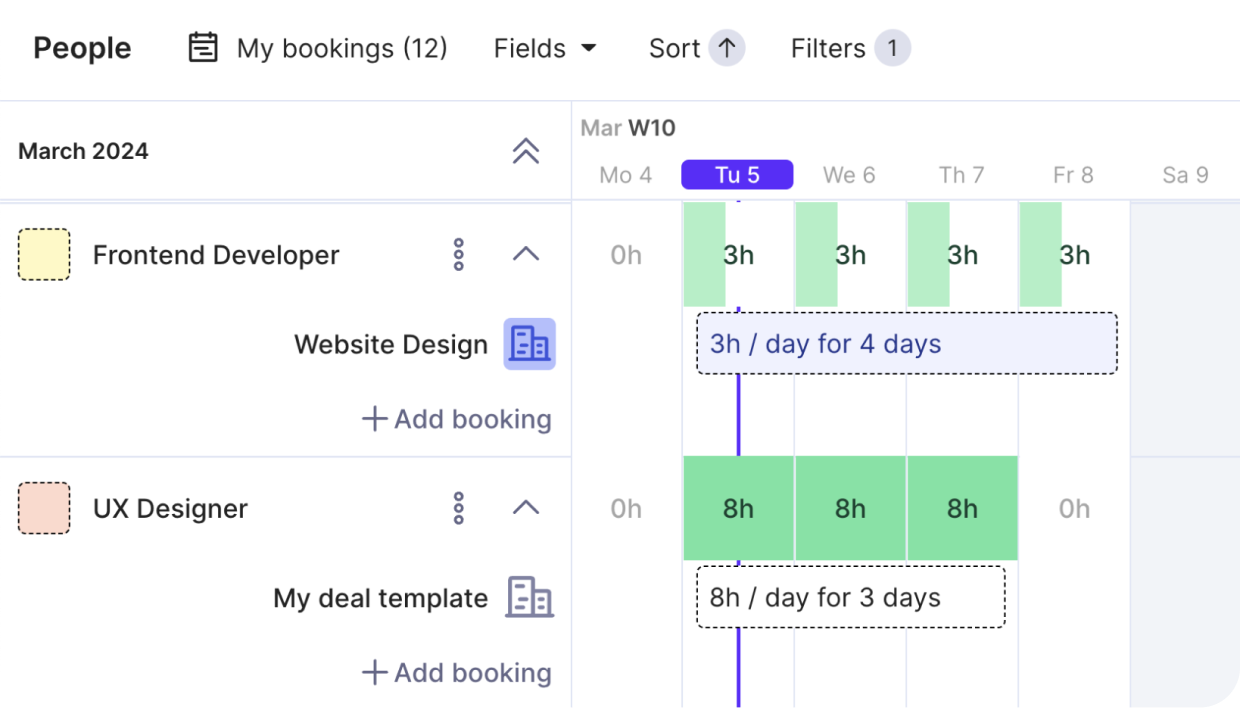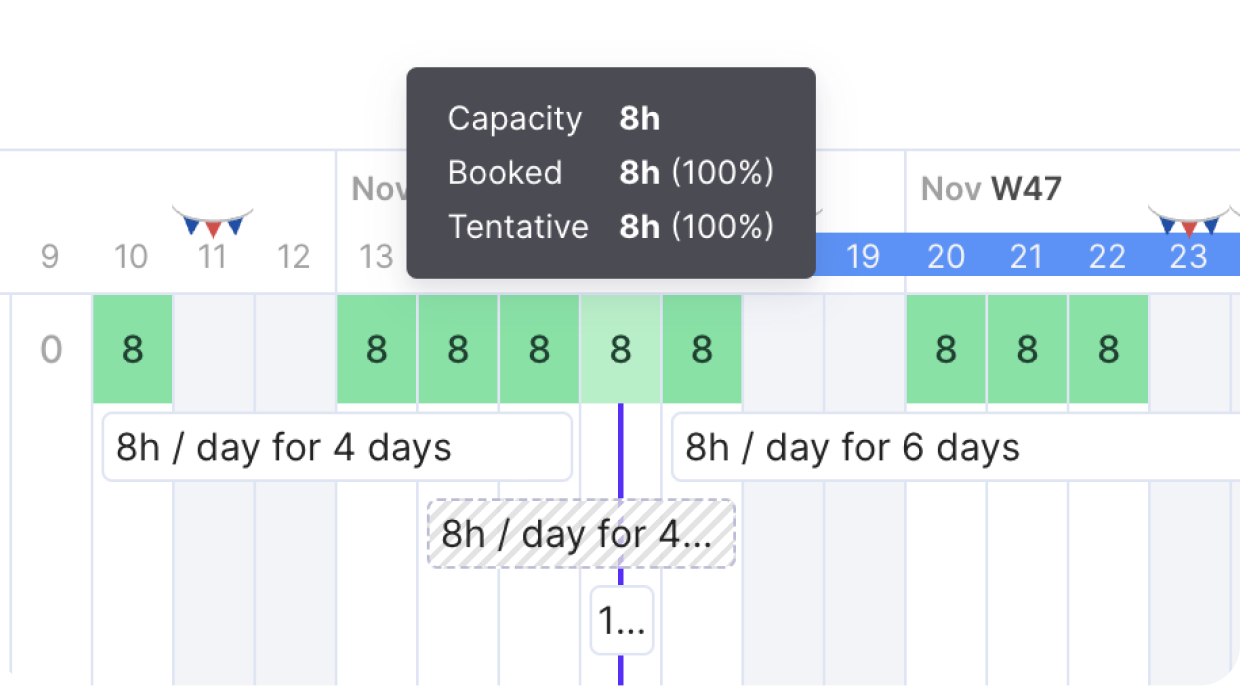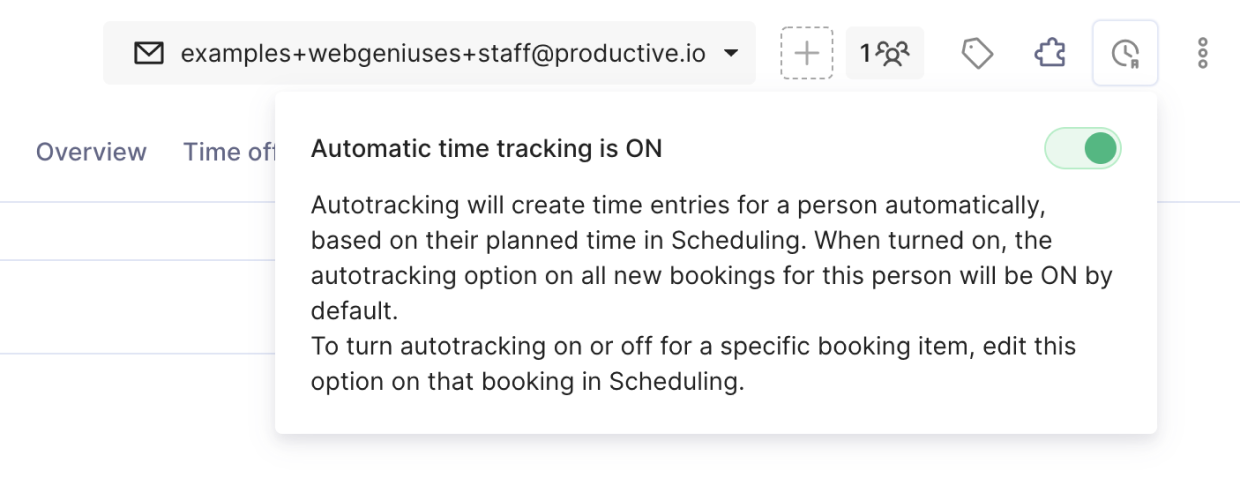The Best Capacity Planning Template for Agencies
Not all capacity planning templates are made equal. You could find various examples online or build them yourself in spreadsheet-based software. For a quick solution, you can download our spreadsheet for capacity planning:
Free Capacity Planning Template
Download our template to schedule time for billable vs non-billable tasks, track workloads, and get insights into utilization with preset formulas.

You can also consider managing your capacity planning process in a platform that integrates professional services time tracking, time off management, and in-depth financial insights.
Keep reading to learn all about the benefits of creating an automated capacity plan and how to build one for your agency.
Why Use a Capacity Planning Template?
Productive’s Resource Planning feature can give you answers to the following questions:
- What are my employees doing right now?
- How are they allocated across projects?
- Which employee has free time to take on a new task?
- Who has taken time off, and for how long?
- How is my project performing financially?

Check out a live demo for Productive’s Resource Planning module
Building Your Capacity Planning Template: Key Steps
We’ll take you through the key capabilities of Productive’s Resourcing to help you get the most out of your agency’s resources. This includes:
1. Planning Your Employees’ Time
Consider how you would create a project capacity planning template with software such as Excel or Google Sheets. Imagine rows and columns of numbers and dates — it would be easy to get lost in this data. In fact, spreadsheet errors are more common than not.
Your resource capacity planning template will not be exempt, as research suggests that more than 90% of spreadsheets have errors, and half of all models in large businesses have material defects. Sometimes, these mistakes can lead to billions of lost revenue (see JP Morgan Chase).
And then there’s Productive, a powerful capacity planning software solution that contains all essential data on your project teams.
Create flexible bookings in a matter of minutes
Productive’s Employment details contain all necessary information for optimal resource scheduling, including who your employees are, their availability, and their cost.
This includes:
- Working hours: You can select specific days and allocate hours for each, in case you have part-time employees.
- Holiday calendar: Each employee has a holiday calendar assigned to them, which helps manage a diverse workforce.
- Time off: You can assign it to each employee if you have specific time off categories, such as maternity or paternity leave.
All of this key information is taken into account when creating your booking. You can also get a handy overview of how many hours you’ve already booked across a service (such as design or development) and how many you have left to account for.

Get a quick overview of hours scheduled across services or check out a full report
Managing Your Bookings
Many errors can occur when changes are made to resource plans. For example, consider what happens if you want to extend or shorten a deadline for specific tasks: You’d have to manually move all dependencies and ensure all your calculations were redone accordingly.
Now picture doing this multiple times a week.
Productive avoids these issues altogether. You don’t have to re-do everything to make the smallest updates to your resource planning templates. If you want to edit an individual booking, you can use drag-and-drop — all information will be updated accordingly. You can also shift, extend, or delete entries in bulk.
Edit your bookings in bulk by pressing the shift button and selecting your entries
Productive also offers repeated bookings for team members working on the same project every week, month, or every couple of weeks.
No More Capacity Planning Templates
Switch from multiple tools and sheets to a single all-in-one software for resource management and real-time data.
Actionable Insights Into Current Resources
Additionally, Productive generates instant insights into your team resources. Forget about combing through mounds of data and collating reports with complex formulas — Productive provides a template library with more than 50 agency-focused Reports.
These templates can be additionally tailored with filters and agency-specific parameters through custom fields.

Visualize your current or future resource distribution across departments and employees
For example, one of the capacity planning reports offered by Productive is Forecasted Billable Utilization by Person or by Month. This report shows your billable vs worked time and resulting billable utilization rate.
You can use these insights to make informed decisions for your long-term capacity planning — for example, if one of your services is underutilized, you can guide sales efforts to try and find clients for that particular department. Or, if certain services are highly utilized, you can consider hiring additional staff.
Find out more about managing your agency’s utilization with Productive:
2. Managing Time Off
According to a study by BreatheHR, UK SMEs spend almost 19 hours a month managing employee leave. Not to mention the difficulties it can cause when analyzing key capacity planning metrics. Take the utilization rate as an example — if you’re examining capacity without accounting for actual team availability, your results will be unreliable.
With Productive, you can set various categories of leave, including paid vacations, half-days off, paid maternity or paternity leave, or more.
For example, you can define:
- Whether a specific category of leave is paid or unpaid
- If employees can request time off in whole days or increments such as hours
- If you want to sync time off with Slack and external calendar applications.

Use Productive to manage time off requests
Requests are also handled from the platform, and once they have been approved, they’re immediately visible in your Resourcing. Additionally, time off bookings can be created similarly to regular bookings — just switch the tab.
See more: Project Resource Management: The Ultimate Guide
Handling Holidays for Remote Teams
When you have employees from various countries, specific holidays can be difficult to account for. With Productive, you don’t have to worry about this. You can import holiday calendars for different countries and assign them to individual resources in their employment details.

Holidays are marked with a specific icon in your Resourcing
Holidays are included in your team’s capacityand are displayed as non-working days. It’s also factored into your utilization report so you can get reliable data on employee efficiency.
3. Using Layouts to Get New Insights
Sometimes, all you need for a breakthrough is a change in perspective. Instead of building additional dashboards from the ground up, Productive lets you switch it up with one click.
Tailor your resourcing to your agency’s working style with three visual representations:
- People: The people view is ideal when you want to focus on balancing employee utilization.
- Projects: The project view helps you plan resources across the project timeline.
- Time off: The time off view lets you check which employees are unavailable at a particular time.
Customize how your resource plan looks with advanced settings
You can also use color-coded representations of resource availability, called capacity indicators or heatmaps, to balance workloads.
4. Handling Future Requirements
Creating an accurate schedule can be hard if you need to account for resources you don’t currently have, or if certain areas of the project are still waiting to be confirmed. Still, handling these circumstances is a key part of a project manager’s job.
Productive offers two types of bookings to help you plan for future demand: placeholders and tentative bookings.
Placeholders
Placeholders can be used to account for future staffing needs. You can also use placeholders to plan ahead and see how adding more capacity affects your project requirements.

Add placeholders to your projects to make your management of resources more effective
Placeholders work like any other employee associated with your current project — they have their cost, working hours, and holiday calendars. You can also add them to your Reports to assess resource utilization and determine hiring needs.
Tentative Bookings
Tentative bookings are another great way to scope out various possibilities. If you’re unsure if your booking will be needed but still want to account for the possibility, you can use tentative bookings to create a plan without impacting your confirmed capacity.

Tentative bookings are grayed out in your resource plan and are indicated in your capacity breakdowns
5. Automatic Time Tracking
You can’t get successful capacity planning if you’re not tracking unbillable and billable hours. Without this data, your agency won’t be able to fully understand its production capacity and future resource availability or identify areas of improvement (see more: scheduled hours vs actual hours).
One of the big benefits of using an integrated capacity planning tool is exactly this — by combining various useful features in a single platform, you can get more complete insights into your crucial agency operations.
Having a platform that considers everybody’s salaries, the operating expenses of the whole business, and feeding that into project budgets and looking at the internal time vs. client time gives us a much more real-time and accurate view of the profitability of actual, specific projects.
As agency management software, Productive offers a Time Tracking feature with a timer and manual entry, but you can also use automatic time tracking through the Resourcing module. This automatically creates time entries that match your resource bookings, so you can save your energy and free up your individual resources.

This also works retroactively, so you can fill in time entries for bookings created in the past.
6. Managing Financials
Getting real-time data is essential to tackling a wide range of capacity planning challenges. With Productive, the allocation of resources is reflected immediately in your key agency metrics, such as budget burn, profitability, and profit margins.

You can view data for future points in time to determine your future resource requirements.
In the Budgeting chart, you can view data such as:
- Billable Time: Time that can be billed to your client
- Scheduled Time: Time allocated using bookings in Resourcing
- Budget Total: Total budget for the project
- Budget Used: Budget spent so far working on the project

As in the budgeting chart, the dotted line depicts the forecasted state of your financials
In the Profitability chart, you can view data such as revenue, cost, profit, and profit margin across time. You can compare whether going over the budget still means the project is profitable, which helps you make better project and agency decisions.
The truth is, we can quickly get a pulse for where we are, at any given time. One way to get a pulse on the business is to get the monthly financials, but for the monthly financials to come in, it takes the accounting department about 15 days after the month ends before we get a picture of how we really did that month. Whereas, with the financial tools that Productive offers, you can check it on a daily basis. We have clear visibility at any given time.
Visualizing and forecasting this key agency data helps you gauge your actual cost, forecast future requirements, anticipate potential risk, and create timely contingency plans.
Learn more about the strategies for developing the best capacity model for your business.
7. Customizing Access Rights
Use permission sets to control which employees can do what. This helps protect sensitive data while providing key team members with essential information on project timelines and resource availability.

Set and create different permission sets across users
You can also build custom permission sets to cater to your team’s needs. Check out Productive’s Permission Builder to learn everything about managing your project visibility.
The Benefits of Capacity Planning Tools
To summarize, using a dedicated resource management tool can bring many benefits to your agency’s capacity management:
- Improved efficiency: Automating your processes reduces team workload and lets employees focus on more critical tasks.
- More reliable data: By switching to a centralized resource planning tool, agencies can benefit from a single data source for all current and future projects.
- Proactive decision-making: Real-time data is important for anticipating and resolving resource conflicts before they can impact project resource expenses.
- Improved project delivery: When you have full insights into your effective capacity, you can avoid over or understaffing your projects, which helps keep tasks on time and projects on budget.
- Capacity building: Manage your list of resources by their specific skill sets and utilization to create an effective capacity building plan for staff.
- Security: Control who can see and do what with customizable permission sets.
Learn more about capacity requirements planning.
Productive – The All-in-One Agency Management Software
There are other ways to manage your agency’s capacity requirements and ensure you meet customer demands. Productive is designed to support agency workflows with various integrated features, from project planning, task management, financial management and forecasting, client invoicing, and more.
What I really like about Productive is that it’s not trying to be a tool for everybody. It’s really a tool for agencies. And I really like that because some of the pain points that an agency has are not addressed by other tools because it’s not something that is a priority for them.
Learn how a digital marketing agency supports its growth with Productive.
Additional features include:
- Gantt chart: Switch between various project views to streamline your management process.
- Time management: Turn your time tracking from a chore to a breeze for employees and resource managers.
- Budgeting: Build budgets of all types and manage billing and external expense tracking.
- Workflow automation: Create custom automations to speed up repetitive workflows.
- Reporting: Access over 50 agency-related reports, create dashboards, and share them with key stakeholders.
- And more: Docs, Sales.
If you’re interested in managing your resource planning and more, book a demo with Productive today.
Connect With Agency Peers
Access agency-related Slack channels, exchange business insights, and join in on members-only live sessions.

